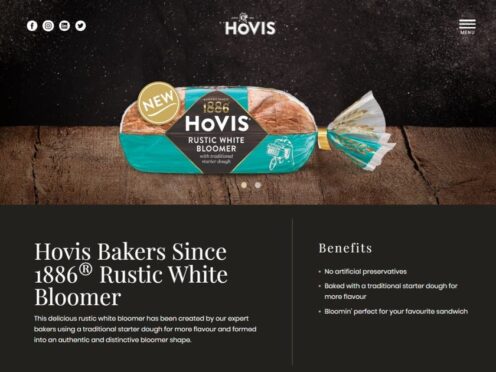
Adverts for “rustic” and “authentic” Hovis bread have been cleared by a watchdog following complaints that the loaves are made using automated industrial techniques and contain “artificial” ingredients.
The three web pages and an Instagram post in September, for the Hovis Rustic White, Rustic Granary and Rustic Seeded Bloomer, said the loaves had been “created by our expert bakers using a traditional starter dough for more flavour and formed into an authentic and distinctive bloomer shape”.
They listed benefits of the loaves as “no artificial preservatives” and “baked with a traditional starter dough for more flavour”.
An ingredients list included the synthetic emulsifier E472e and ascorbic acid – otherwise known as Vitamin C – as a flour treatment agent.
Sustain’s Real Bread Campaign, which understood that the bread was produced using automated industrial techniques and included “artificial preservatives”, complained to the Advertising Standards Authority (ASA) that the ads were misleading.
Hovis said the Cambridge Online Dictionary defined rustic as “simple and often rough in appearance; typical of the countryside”, adding that none of its rustic bloomers were made using the Chorleywood process – a high-speed mixing process combined with dough conditioners.
They used the term “authentic” in a “limited context only”, when referring to the bloomer shape and not the product more generally, and said the term “traditional” was fitting when referring to the starter dough.
Hovis said it did not describe the bread as “artisanal” or “made by artisans” and the language was clear that the product was simply influenced by artisans, adding that “consumers readily understood the difference”.
Finally, Hovis said E472e, the food additive number for DATEM – an abbreviation of diacetyl tartaric acid ester of mono- and diglycerides, was the most commonly used emulsifier in bread products and was recognised as a dough conditioner, explaining that it was not added as a preservative.
It said ascorbic acid was classified by the Food Standards Agency as an antioxidant and not as a preservative.
The ASA did not uphold any part of the Real Bread Campaign’s complaint, ruling that because the Hovis brand was well known, the ads appeared on their own website and Instagram page and the products were shown in plastic packaging, “consumers would understand that the products had been produced on an industrial scale”.
The regulator added: “Furthermore, we considered that consumers would understand that the products had been produced on an industrial scale and therefore probably contained some additional ingredients other than the basic ingredients required to make bread.
“Because the breads did not contain any preservatives and the lists of ingredients were presented clearly alongside the claim which made clear that they contained other additives, we concluded that the claim ‘no artificial preservatives’ was not misleading.”
Real Bread Campaign coordinator Chris Young said: “Shoppers need clear, honest information in order to make better-informed choices.
“When corporations use language like ‘artisan’ or ‘authentic’, they are implying the product is produced to better standards.
“In our view people are having the wool pulled over their eyes, which is made even worse when they’re being charged higher prices for supposedly ‘premium’ products that are arguably little different from other industrial loaves.”

Enjoy the convenience of having The Sunday Post delivered as a digital ePaper straight to your smartphone, tablet or computer.
Subscribe for only £5.49 a month and enjoy all the benefits of the printed paper as a digital replica.
Subscribe